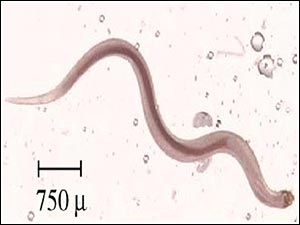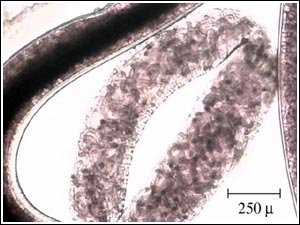

 |
||||||||||||
 |
||||||||||||
| Nematode (Roundworm) Infections in Fish | ||||||
| Page 9 of 11 | Pages: 1 . 2 . 3 . 4 . 5 . 6 . 7 . 8 . 9 . 10 . 11 | |||||
Camallanus Species Camallanus species ( Figure 12 ) infect the gastrointestinal tract of cichlids, live-bearers (including guppies and swordtails), and other species of freshwater fish. Usually, the first evidence of infection is a red, worm-like animal protruding from the anus of a fish.  Figure 12: Juvenile Camallanus nematode from a fire mouth cichlid.
Figure 12: Juvenile Camallanus nematode from a fire mouth cichlid.
Camallanus species have indirect life cycles and are live-bearing nematodes. They are considered "ovoviviparous" ("ovo" is the scientific term for "egg" and "viviparous" means live-bearing), as females incubate the eggs which hatch into larvae within their bodies ( Figure 13 ). These larvae are excreted into the water with the fish's feces and are ingested by a copepod or other crustacean. Within the copepod, the larvae develop further into a third-stage larvae. After the copepod, containing the third-stage larvae, is eaten by the appropriate fish host, the larvae migrate out into the fish, develop into reproductive adults, and the life cycle is complete.  Figure 13: Close up of a Camallanus sp. female showing larvae inside.
Figure 13: Close up of a Camallanus sp. female showing larvae inside.
Diagnosis Camallanus species can be identified by their red color; their location further toward the posterior of the intestinal tract than other worm-like parasites (typically very near, and often protruding from, the anus of the fish); the presence of a buccal capsule (mouth structure) that is divided into two lateral valves, giving the mouth a slit like appearance; and, if gravid females are present, the presence of both eggs and larvae within their bodies. Positive identification will require the assistance of an expert. Treatment Because Camallanus nematodes are located within the intestinal tract, common dewormers should be effective. Prevention As a copepod or other crustacean host is required to complete the life cycle, avoiding the use of copepods or related crustaceans as food items will help reduce potential for infection. Evaluation of brood stock for the presence of parasites prior to use will also aid in identifying carriers. more ... |
 |
|||||
| About Us :: Message Board :: Chat | |||||
| Library :: Photo Gallery :: Links & Resources :: Breeders & Sponsors :: Merchandise | |||||
| Website designed by: EthanCote.com | © 2001-2004, SimplyDiscus.com. All Rights Reserved. | ||||